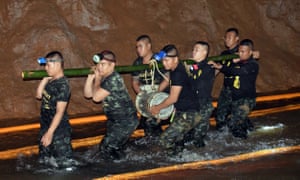The 12 boys and their football coach found alive in a Thailand cave could be stuck there for months, the country’s military has said as it prepares to bring in long-term food supplies and diving training for the stranded group.
A team of two British divers found the team in the flooded cave system in Thailand’s Chiang Rai province, nine days after the boys aged 11 to 16 and their 25 year-old coach went missing. Their story of resilience under dire circumstances has captivated people around the world.
However, bringing the boys and their coach up to the surface is a complicated task. Engineers have been pumping water out of the cave for a week, and a temporary respite from the rains has also lowered water levels. By Tuesday they were removing 10,000 litres of water an hour, lowering the water level by a centimetre every hour.
But heavy precipitation expected in the coming days, as the rainy season begins, could severely hamper rescue efforts and the boys might have to wait as long as several months for the waters to recede to safe levels.
Thai navy captain Anand Surawan said: “[We will] prepare to send additional food to be sustained for at least four months and train all 13 to dive while continuing to drain the water.”
Peter Wolf, the national director of the Cave Divers Association of Australia, said: “The best option is to leave them where they are and stabilise their environment to make sure the core ingredients are met. Given the environment is pretty wet, to keep them warm and dry, provide them with clean drinking water, food, and clean air.
“Depending on the size of the chamber they’re in, the clean air is a concern as well.”
None of the boys can swim or dive, and Edd Sorenson of International Cave Rescue and Recovery warned it would be “unbelievably dangerous” for someone with no experience to navigate the cave with near-zero visibility and rushing water.
“As long as the kids know we know where they’re at, they have food, a way to keep warm, water or filtration systems and light, it would really be the safest to wait it out. But taking them in the water would be extremely dangerous for the kids and the coach but also for the rescuers.”

It is thought the 12 boys and their coach entered the cave on 23 June, before a sudden monsoon flooded the 10km network. The group was found huddled on a mud bank two metres above the water level, taking shelter there as water around them rose. The wet season typically lasts from May to October in northern Thailand on the borders with Laos and Myanmar, where the Tham Luang cave is located.
Since the group were found alive on Monday, divers have supplied the boys and their coach with energy gel to eat, and two Thai Navy medical personnel have joined the group to keep them company and monitor the boys as they await rescue, according to the Navy Seals Facebook page.
Wolf said the length of the cave and the conditions meant “there are probably very few people on the planet who can actually get those provisions to them”.
Officials at the cave said most of the boys were in a stable medical condition, and none were in a critical state.
Narongsak Osatanakorn, the governor of Chiang Rai province, said on Tuesday morning that rescuers had classified the boys using a traffic light system: red (critical condition), yellow (serious) or green (stable). “We found that most of the boys are in green condition,” he said, according to the Associated Press. “Maybe some of the boys have injuries or light injuries and would be categorised as yellow condition. But no one is in red condition.”
“We called this mission impossible because it rained every day … but with our determination and equipment we fought nature.”
He said the final decision on when and how to evacuate the boys lies with the Thai navy, and one option under consideration was to teach them to swim using a type of breathing mask. Search teams had been deployed to look for other ways into the cave network.
Divers said the temperature in the cave was a about 26 degrees, with water dripping from the walls, meaning the children were unlikely to have experienced dehydration and hypothermia.
Ben Reymenants, a Dutch rescuer who is part of the international team which is assisting the Thai authorities, told the BBC: “The issue is that time is not really on our side because they’re expecting heavy rains within three days and the cave system [could] just flood, making access impossible for the kids.”

The group is between 800 metres and a kilometre below the surface, and roughly two kilometres inside the cave. Bill Whitehouse, vice chair of the British Cave Rescue Council: “They are also located in a relatively small space and this would make any potential drilling attempt as a means of rescue very difficult.”
The Thai prime minister, Prayuth Chan-ocha, held a telephone conference to congratulate the rescuers at the cave site.
The boys were reportedly familiar with the cave. Tham Luang cave is one of Thailand’s longest and one of the toughest to navigate, with snaking chambers and narrow passageways. A sign outside the site warns visitors not to enter the cave during the rainy season.
Officials were also installing telephone lines to allow the children to speak to their parents, Germany news agency DPA reported.
More than 1,000 Thai military personnel are at the site as well as teams from seven countries, including the UK, US and Australia.




